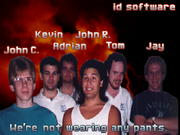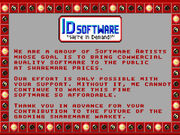(Created page with "thumb|The cast photo secret included in [[Spear of Destiny]]ID Software (sometimes "id Software") is a video gam...") |
No edit summary Tag: Visual edit |
||
| Line 4: | Line 4: | ||
==The Early Years== |
==The Early Years== |
||
[[File:1253866-idsoft.jpg|thumb|The ID Software screen in Commander Keen which included the "We're In Demand!" tagline which ID originally stood for]]ID Software was originally founded by ex [[SoftDisk]] employees [[Tom Hall]], [[John Carmack]], [[John Romero]], and [[Adrian Carmack]]. The company's early ambitions were to use John Carmack's programming expertise to pitch a PC port of Super Mario Bros 3 to Nintendo. After Nintendo declined due to negative experiences with similar projects in the past, ID used the side-scrolling tech Carmack had pioneered and Hall's creative design to create [[Commander Keen (Game)|Commander Keen]]. |
[[File:1253866-idsoft.jpg|thumb|The ID Software screen in Commander Keen which included the "We're In Demand!" tagline which ID originally stood for]]ID Software was originally founded by ex [[SoftDisk]] employees [[Tom Hall]], [[John Carmack]], [[John Romero]], and [[Adrian Carmack]]. The company's early ambitions were to use John Carmack's programming expertise to pitch a PC port of Super Mario Bros 3 to Nintendo. After Nintendo declined due to negative experiences with similar projects in the past, ID used the side-scrolling tech Carmack had pioneered and Hall's creative design to create [[Commander Keen (Game)|Commander Keen]]. |
||
| − | Commander Keen was published in 1990 by [ |
+ | Commander Keen was published in 1990 by [https://en.wikipedia.org/wiki/3D_Realms Apogee] who convinced ID of the power of the shareware model for marketing. After the first 3 episodes of Keen were a success, ID created 2 more with Apogee and then one more with [[FormGen]]. During this time they also hired freelance musician [[Bobby Prince]] to create music for their games as well as programmer [[Jason Blochowiak]] who created the id music format. |
Despite this success, John Romero and John Carmack wanted to move away from family-friendly games and push the envelope a bit more. |
Despite this success, John Romero and John Carmack wanted to move away from family-friendly games and push the envelope a bit more. |
||
==Wolfenstein 3D== |
==Wolfenstein 3D== |
||
Revision as of 14:43, 1 September 2019

The cast photo secret included in Spear of Destiny
ID Software (sometimes "id Software") is a video game development company based in Dallas Texas. It's known as the company responsible for creating Wolfenstein 3D, Spear of Destiny, Doom, Quake, and several other games.
History
The Early Years

The ID Software screen in Commander Keen which included the "We're In Demand!" tagline which ID originally stood for
ID Software was originally founded by ex SoftDisk employees Tom Hall, John Carmack, John Romero, and Adrian Carmack. The company's early ambitions were to use John Carmack's programming expertise to pitch a PC port of Super Mario Bros 3 to Nintendo. After Nintendo declined due to negative experiences with similar projects in the past, ID used the side-scrolling tech Carmack had pioneered and Hall's creative design to create Commander Keen.
Commander Keen was published in 1990 by Apogee who convinced ID of the power of the shareware model for marketing. After the first 3 episodes of Keen were a success, ID created 2 more with Apogee and then one more with FormGen. During this time they also hired freelance musician Bobby Prince to create music for their games as well as programmer Jason Blochowiak who created the id music format. Despite this success, John Romero and John Carmack wanted to move away from family-friendly games and push the envelope a bit more.
Wolfenstein 3D

The team at ID in 1993 from left to right: John Carmack, Kevin Cloud, Adrian Carmack, John Romero, Tom Hall, and Jay Wilbur
It has been said that John Romero was the one to pitch the idea of recreating Muse Software's Escape from Castle Wolfenstein. During early development, ID didn't know if Muse would allow them to use the name "Wolfenstein" so they created several alternative titles they could use, some of which ended up as episode names or names of castle locations in the game. As it turned out the name Wolfenstein was up for grabs so ID got to use it after all.
During development ID was joined by Jay Wilbur, who handled some of the business aspects of the company, and Kevin Cloud, who came on as an artist. Wolfenstein 3D was originally planned to have several stealth elements implemented, including stealth attacks and dragging bodies. However, this was all found to be unintuitive and was cut in favor of a more tactical-shooter approach. Wolfenstein 3D ultimately proved to be the final game ID published through Apogee. Its first episode was released as shareware and the following two episodes were sold as the full version. An additional three episodes, known as "The Nocturnal Missions," could be purchased as well to complete the game. Only a few months later the 21 level set Spear of Destiny was released through FormGen. Spear of Destiny did not follow the shareware model, but did release the first two levels as a demo. An addition two sets known colloquially as the Spear Mission Packs (Lost Episodes) were created inhouse at FormGen without ID's involvement.